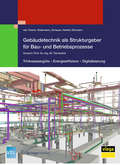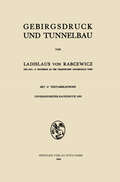- Table View
- List View
Gear Cutting Tools: Science and Engineering, Second Edition
by Stephen P. RadzevichGear Cutting Tools: Fundamentals of Design and Computation, Second Edition, presents the DG/K-based method of surface generation, a practical mathematical method for designing gear cutting tools with optimal parameters. The text addresss gear cutting tool evolution, and proceeds to scientific classification for all types of gear machining meshes before discussing optimal cutting tool designs. Designs currently used and those being planned are covered, and the approach allows for development of scientific predictions and optimal designs. Solutions appear in analytical form and/or graphical form, with a wealth of new figures added, and new appendices offer additional data for readers.
Gear Cutting Tools: Fundamentals of Design and Computation
by Stephen P. RadzevichThis book presents the DG/K-based method of surface generation, a novel and practical mathematical method for designing gear cutting tools with optimal parameters. The author, an industry leader for the past 30 years, proposes a scientific classification for all possible kinds of the gear machining meshes before discussing optimal designs of gear c
Gear Cutting Tools: Science and Engineering, Second Edition
by Stephen P. RadzevichGear Cutting Tools: Fundamentals of Design and Computation, Second Edition, presents the DG/K-based method of surface generation, a practical mathematical method for designing gear cutting tools with optimal parameters. The text addresss gear cutting tool evolution, and proceeds to scientific classification for all types of gear machining meshes before discussing optimal cutting tool designs. Designs currently used and those being planned are covered, and the approach allows for development of scientific predictions and optimal designs. Solutions appear in analytical form and/or graphical form, with a wealth of new figures added, and new appendices offer additional data for readers.
Gear Drive Systems: Design and Application (Mechanical Engineering #20)
by Peter LynwanderThis outstanding reference provides the complete range of practical and theoretical information - with over 250 detailed illustartions, fugures and table- needed to design, manufacture and operate reliable, efficient gear drive systems, emphasizing parallel shaft and planetary units with spur and helical gearing.
Gear Drive Systems: Design and Application (Mechanical Engineering #20)
by Peter LynwanderThis outstanding reference provides the complete range of practical and theoretical information - with over 250 detailed illustartions, fugures and table- needed to design, manufacture and operate reliable, efficient gear drive systems, emphasizing parallel shaft and planetary units with spur and helical gearing.
Gear Motor Handbook
by D. W. Dudley J. Sprengers D. Schröder H. YamashinaIn these years of constant growth and further development for our company, research and development has become more and more important, and has allowed us to be at the forefront in our business sector, where innovation is the obvious and decisive factor. It has therefore been consistent with our everyday business philosophy to involve ourselves deeply in writing and printing this handbook, which is designed to recognize the capacity and hard work of all employees working successfully in the Bonfiglioli Group. The book is intended to be a concrete contribution by Bonfiglioli Riduttori S.p.A. to the development and application of power transmissions. The book is addressed to all who have technical dealings with power transmissions, from university students to engineers active in the workplace. For this reason we have invited the cooperation of four prestigious professionals - Darle W. Dudley, Jacques Sprengers, Dierk SchrOder, and Hajime Yamashina - in the knowledge that only through the cooperation of the leading specialists in the field of power transmissions could we develop a truly useful and helpful handbook. It has been hard work, but we are sure the reader's appreciation will amply reward our efforts.
Gear Noise and Vibration
by J. Derek SmithBased on over 40 years of consultation and teaching experience, Gear Noise and Vibration demonstrates logical gear noise and vibration approaches without the use of complex mathematics or lengthy computation methods. The second edition offers new and extended discussions on high- and low-contact ratio gears, lightly loaded gears, planetary and spli
Gearing up and accelerating cross‐fertilization between academic and industrial robotics research in Europe: Technology transfer experiments from the ECHORD project (Springer Tracts in Advanced Robotics #94)
by Florian Röhrbein Germano Veiga Ciro NataleThis monograph by Florian Röhrbein, Germano Veiga and Ciro Natale is an edited collection of 15 authoritative contributions in the area of robot technology transfer between academia and industry. It comprises three parts on Future Industrial Robotics, Robotic Grasping as well as Human-Centered Robots. The book chapters cover almost all the topics nowadays considered ‘hot’ within the robotics community, from reliable object recognition to dexterous grasping, from speech recognition to intuitive robot programming, from mobile robot navigation to aerial robotics, from safe physical human-robot interaction to body extenders. All contributions stem from the results of ECHORD – the European Clearing House for Open Robotics Development, a large-scale integrating project funded by the European Commission within the 7th Framework Programme from 2009 to 2013. ECHORD’s two main pillars were the so-called experiments, 52 small-sized industry-driven research projects, and the structured dialog, a powerful interaction instrument between the stakeholders. The results described in this volume are expected to shed new light on innovation and technology transfer from academia to industry in the field of robotics.
Gearing Up and Accelerating Cross‐fertilization between Academic and Industrial Robotics Research in Europe: Technology Transfer Experiments from the ECHORD Project (Springer Tracts in Advanced Robotics #94)
by Florian Röhrbein Germano Veiga Ciro NataleThis monograph by Florian Röhrbein, Germano Veiga and Ciro Natale is an edited collection of 15 authoritative contributions in the area of robot technology transfer between academia and industry. It comprises three parts on Future Industrial Robotics, Robotic Grasping as well as Human-Centered Robots. The book chapters cover almost all the topics nowadays considered ‘hot’ within the robotics community, from reliable object recognition to dexterous grasping, from speech recognition to intuitive robot programming, from mobile robot navigation to aerial robotics, from safe physical human-robot interaction to body extenders. All contributions stem from the results of ECHORD – the European Clearing House for Open Robotics Development, a large-scale integrating project funded by the European Commission within the 7th Framework Programme from 2009 to 2013. ECHORD’s two main pillars were the so-called experiments, 51 small-sized industry-driven research projects and the structured dialog a powerful interaction instrument between the stakeholders. The results described in this volume are expected to shed new light on innovation and technology transfer from academia to industry in the field of robotics.
Gears: Volume 2: Analysis of Load Carrying Capacity and Strength Design (Springer Series in Solid and Structural Mechanics #11)
by Vincenzo VulloThis book explores the geometric and kinematic design of the various types of gears most commonly used in practical applications, also considering the problems concerning their cutting processes. The cylindrical spur and helical gears are first considered, determining their main geometric quantities in the light of interference and undercut problems, as well as the related kinematic parameters. Particular attention is paid to the profile shift of these types of gears either generated by rack-type cutter or by pinion-rack cutter. Among other things, profile-shifted toothing allows to obtain teeth shapes capable of greater strength and more balanced specific sliding, as well as to reduce the number of teeth below the minimum one to avoid the operating interference or undercut. These very important aspects of geometric-kinematic design of cylindrical spur and helical gears are then generalized and extended to the other examined types of gears most commonly used in practical applications, such as straight bevel gears; crossed helical gears; worm gears; spiral bevel and hypoid gears. Finally, ordinary gear trains, planetary gear trains and face gear drives are discussed. This is the most advanced reference guide to the state of the art in gear engineering. Topics are addressed from a theoretical standpoint, but in such a way as not to lose sight of the physical phenomena that characterize the various types of gears which are examined. The analytical and numerical solutions are formulated so as to be of interest not only to academics, but also to designers who deal with actual engineering problems concerning the gears
Gears: Volume 1: Geometric and Kinematic Design (Springer Series in Solid and Structural Mechanics #10)
by Vincenzo VulloThe book explores the geometric and kinematic design of the various types of gears most commonly used in practical applications, also considering the problems concerning their cutting processes. The cylindrical spur and helical gears are first considered, determining their main geometric quantities in the light of interference and undercut problems, as well as the related kinematic parameters. Particular attention is paid to the profile shift of these types of gears either generated by rack-type cutter or by pinion-rack cutter. Among other things, profile-shifted toothing allows to obtain teeth shapes capable of greater strength and more balanced specific sliding, as well as to reduce the number of teeth below the minimum one to avoid the operating interference or undercut. These very important aspects of geometric-kinematic design of cylindrical spur and helical gears are then generalized and extended to the other examined types of gears most commonly used in practical applications, such as: straight bevel gears; crossed helical gears; worm gears; spiral bevel and hypoid gears. Finally, ordinary gear trains, planetary gear trains and face gear drives are discussed. Includes fully-developed exercises to draw the reader's attention to the problems that are of interest to the designer, as well as to clarify the calculation procedure Topics are addressed from a theoretical standpoint, but in such a way as not to lose sight of the physical phenomena that characterize the various types of gears which are examined The analytical and numerical solutions are formulated so as to be of interest not only to academics, but also to designers who deal with actual engineering problems concerning the gears
Gears: Volume 3: A Concise History (Springer Series in Solid and Structural Mechanics #12)
by Vincenzo VulloThis book provides a compact history of gears, by summarizing the main stages of their development and the corresponding gradual acquisition of engineering expertise, from the antiquity to the Renaissance and the twentieth century. This brief history makes no claim to be exhaustive, since the topic is so extensive, complex and fascinating that it deserves an entire encyclopedia. Despite its brevity, the book debunks a number of popular misconceptions, such as the belief that the first literary description of a gear was supplied by Aristotle. It disproves not only this myth, but also other peremptory statements and/or axiomatic assumptions that have no basis in written documents, archaeological findings or other factual evidence. The book is chiefly intended for students and lecturers, historians of science and scientists, and all those who want to learn about the genesis and evolution of this topic.
Gears and Gear Drives
by Damir T. JelaskaUnderstanding how gears are formed and how they interact or ‘mesh’ with each other is essential when designing equipment that uses gears or gear trains. The way in which gear teeth are formed and how they mesh is determined by their geometry and kinematics, which is the topic of this book. Gears and Gear Drives provides the reader with comprehensive coverage of gears and gear drives. Spur, helical, bevel, worm and planetary gears are all covered, with consideration given to their classification, geometry, kinematics, accuracy control, load capacity and manufacturing. Cylindrical gear geometry is the basis for dealing with any gear drives, so this is covered in detail. Key features: Contains hundreds of 2D and 3D figures to illustrate all types of gears and gear drives, including planetary and worm gears Includes fundamental derivations and explanations of formulae Enables the reader to know how to carry out accuracy control and load capacity checks for any gear drive Includes directions for the practical design of gears and gear drives Covers DIN and ISO standards in the area Gears and Gear Drives is a comprehensive reference for gears and gear drive professionals and graduate students in mechanical engineering departments and covers everything important to know how to design, control and manufacture gear drives.
Gears and Gear Drives
by Damir T. JelaskaUnderstanding how gears are formed and how they interact or ‘mesh’ with each other is essential when designing equipment that uses gears or gear trains. The way in which gear teeth are formed and how they mesh is determined by their geometry and kinematics, which is the topic of this book. Gears and Gear Drives provides the reader with comprehensive coverage of gears and gear drives. Spur, helical, bevel, worm and planetary gears are all covered, with consideration given to their classification, geometry, kinematics, accuracy control, load capacity and manufacturing. Cylindrical gear geometry is the basis for dealing with any gear drives, so this is covered in detail. Key features: Contains hundreds of 2D and 3D figures to illustrate all types of gears and gear drives, including planetary and worm gears Includes fundamental derivations and explanations of formulae Enables the reader to know how to carry out accuracy control and load capacity checks for any gear drive Includes directions for the practical design of gears and gear drives Covers DIN and ISO standards in the area Gears and Gear Drives is a comprehensive reference for gears and gear drive professionals and graduate students in mechanical engineering departments and covers everything important to know how to design, control and manufacture gear drives.
Gears in Design, Production and Education: A Tribute to Prof. Veniamin Goldfarb (Mechanisms and Machine Science #101)
by Natalya Barmina Evgenii TrubachevThis book is the fourth volume in the series devoted to gear engineering and computer-aided design, production, testing and education. It comprises fundamental and applied research contributions by scientists and gear experts from all the world and covers recent developments and historical achievements in various spheres of mechanical engineering related to different kinds of gears, transmissions, and drive systems. It gathers contributions describing the advanced approaches to research, design, testing and production of practically all common and new kinds of gears for a vast number of advanced applications. Special attention is paid to issues of higher education in the field of gears. The book is intended as a tribute to professor Veniamin Goldfarb (1941-2019), one of the world-known leaders in the field of gear research, education and production, who contributed much to the active international cooperation of gear experts and to promotion of MMS science. The introductory chapter of this book relates his research to major developments in the field of mechanisms and machine science and outlines important contributions that he made within the period of 1964-2019.
Gebäude.Technik.Digital.: Building Information Modeling (VDI-Buch)
by Christoph Treeck, van Robert Elixmann Klaus Rudat Sven Hiller Sebastian Herkel Markus BergerBIM ist nach dem Stufenplan für Deutschland »eine kooperative Arbeitsmethodik, mit der auf der Grundlage digitaler Modelle eines Bauwerks die für seinen Lebenszyklus relevanten Informationen und Daten konsistent erfasst, verwaltet und in einer transparenten Kommunikation zwischen den Beteiligten ausgetauscht oder für die weitere Bearbeitung übergeben werden«.Vor diesem Hintergrund hilft virtuelles Bauen, Zeitpläne und Kosten einzuhalten und Risiken zu minimieren. Planänderungen können zeit- und kosteneffizient über sämtliche Realisierungsebenen hinweg interpretations- und fehlerfrei realisiert werden. Schließlich profitiert das Facility Management durch die konsequente Weiternutzung der digitalen Gesamtdokumentation in der Betriebs- und Nutzungsphase.Dieses Fachbuch beschreibt den Status Quo dieser neuen Disziplin, die sich zunehmend z.B. bei öffentlichen Ausschreibungen – auch international – zu einer verbindlichen Konvention entwickelt. In diesem Kontext werden neueste Erkenntnisse und Trends für die Anwendung der Methode BIM in der Praxis in den Gewerken Trinkwasser, Energie und Brandschutz reflektiert sowie auch die rechtlichen Aspekte zukunftsweisend erläutert.
Gebäudeautomation in Wohn- und Wirtschaftsimmobilien: Energetische Einsparpotenziale durch Gebäudeautomation (Studien zum nachhaltigen Bauen und Wirtschaften)
by Giulio Saric Thomas GlatteMit Gebäudeautomation lassen sich Komfort und Sicherheit eines Gebäudes steigern. Dazu kommt das Potenzial, die Energieeffizienz der Immobilie zu erhöhen, was wirschaftliche Vorteile bei der Bewirtschaftung mit sich bringt. Diese Publikation untersucht verschiedene Smart-Home Technologien im Hinblick auf die Senkung der Energiekosten und vergleicht den ökonomischen Nutzen zwischen Wirtschafts- und Wohnimmobilien. Dabei werden die Anwendungsfelder Beleuchtung, Klimatisierung und Beschattung analysiert und bewertet.
Gebäudeautomation in Wohngebäuden (Smart Home): Eine Analyse der Akzeptanz
by Karolin WisserNeben der Beschreibung der Gebäudeautomation aus technischer Sicht und der Erläuterung der Akzeptanzforschung, erfolgt eine differenzierte Akzeptanzanalyse. Zum einen wird die bloße Einstellung der Menschen zur Gebäudeautomation in Wohngebäuden untersucht, zum anderen werden die Faktoren analysiert, die zu einer Anschaffung der Gebäudeautomation führen oder diese verhindern. Darüber hinaus wird die Nutzungsphase, genauer die Akzeptanz bei der tatsächlichen Nutzung betrachtet. Beleuchtet werden zudem die Potenziale dieser Technologie und deren Realisierung.
Gebäudeplanung und Betrieb: Einfluß der Gebäudeplanung auf die Wirtschaftlichkeit von Betrieben (Praxis der Bauwirtschaft)
by Wolfdietrich KaluscheDas Buch behandelt den Einfluß der Gebäudeplanung auf die Wirtschaftlichkeit von Betrieben: Baukosten, Sicherung der Bedingungen für die vorgesehene Gebäudenutzung, Betriebskosten und Bauunterhaltungskosten, Personal- und Sachkosten. Ausführlich werden die Eigenschaften geplanter Gebäude auf die späteren Personal- und Sachkosten diskutiert.
Gebäudetechnik als Strukturgeber für Bau- und Betriebsprozesse: Trinkwassergüte – Energieeffizienz - Digitalisierung (VDI-Buch)
by Van Christoph Treeck Thomas Kistemann Christian Schauer Sebastian Herkel Robert ElixmannDie Gebäudetechnik steht vor einem bedeutenden Paradigmenwechsel. Getrieben durch die Integrale Planung und verknüpft mit der Methodik des Building Information Modelings (BIM) sowie den neuen Möglichkeiten der Digitalisierung (Stichwort: Internet of Things; IoT), tritt die ganzheitliche Betrachtung von digital unterstützten Prozessen in den Fokus und erfordert von Fachplanern eine neue Handlungsmaxime. Vor diesem Hintergrund beleuchtet dieses Fachbuch die konzeptionellen und rechtlichen Rahmenbedingungen, innerhalb derer sich dieser Paradigmenwechsel vollziehen wird. Danach gilt es zukünftig mehr denn je, die teils konkurrierenden Schutzziele wie Energieeffizienz oder Erhalt der Trinkwassergüte mit zeitgemäßen Komfortansprüchen bei zu vertretenden Kosten in Einklang zu bringen. Aufbauend auf den aktuellsten wissenschaftlichen und technischen Erkenntnissen werden dafür planerische und technologische Lösungswege aufgezeigt, wie sie heute schon praxisgerecht bei der Planung und in einem bedarfsgerechten und hocheffizienten Anlagenbetrieb umgesetzt werden können.
Gebäudetechnik für Trinkwasser: Fachgerecht planen - Rechtssicher ausschreiben - Nachhaltig sanieren (VDI-Buch)
by Thomas Kistemann Werner Schulte Klaus Rudat Wolfgang Hentschel Daniel HäußermannSeit Inkrafttreten der neuen Trinkwasserverordnung am 1. November 2011 muss Trinkwasser aus gewerblich genutzten Installationen jährlich untersucht werden. In dem Band werden neueste Forschungsergebnisse, aktuelle Richtlinien, Normen und Gesetze für die Planung hygienegerechter Anlagen vorgestellt. Die Autoren liefern kommentierte Berechnungsbeispiele, sie diskutieren die Ursachen für mikrobiologisch kontaminierte Altanlagen sowie deren Sanierung und erläutern die rechtlichen Rahmenbedingungen für Planung, Ausschreibung und Anlagenbetrieb.
Gebäudetechnik für Trinkwasser: Fachgerecht planen - Rechtssicher ausschreiben - Nachhaltig sanieren (VDI-Buch)
by Thomas Kistemann Werner Schulte Klaus Rudat Wolfgang Hentschel Daniel HäußermannSeit Inkrafttreten der neuen Trinkwasserverordnung am 1. November 2011 muss Trinkwasser aus gewerblich genutzten Installationen jährlich untersucht werden. In dem Band werden neueste Forschungsergebnisse, aktuelle Richtlinien, Normen und Gesetze für die Planung hygienegerechter Anlagen vorgestellt. Die Autoren liefern kommentierte Berechnungsbeispiele, sie diskutieren die Ursachen für mikrobiologisch kontaminierte Altanlagen sowie deren Sanierung und erläutern die rechtlichen Rahmenbedingungen für Planung, Ausschreibung und Anlagenbetrieb.
Gebäudetechnik und Technischer Ausbau von Gebäuden
by Dirk BohneAuf dem neuesten “Stand der Technik” präsentiert sich das Buch noch übersichtlicher mit einer neu gegliederten, äußerst benutzerfreundlichen Darbietung des Stoffes. Das Fachwissen wurde dabei konzentriert und komprimiert auf die für Architekten und Bauingenieure relevanten Sachverhalte und Zusammenhänge. Komplett neu gestaltet wurde der umfangreiche Abbildungsteil mit hochwertigen Zeichnungen zur bildhaften Kommentierung des Textes. Um im Technischen Ausbau mit der technologischen Entwicklung, den steigenden Komfortansprüchen und den Erfordernissen eines wirtschaftlichen und umweltfreundlichen Umgangs mit der Energie Schritt zu halten, ist der “Wellpott/ Bohne” weiterhin ein unverzichtbares Grundlagenbuch.
Geberlose Rotorlagebestimmung in elektrischen Maschinen: Spannungsbasierte Verfahren für permanentmagneterregte Synchronmotoren
by Timur WernerTimur Werner stellt eine stringente Modellierung permanentmagneterregter Synchronmaschinen vor und analysiert darauf aufbauend verschiedene Verfahren zur geberlosen Lageerfassung nahe Stillstand. Auf dieser Basis wird eine Methodik aufgezeigt, die nur mithilfe von Ergebnissen einer FEM-Berechnung und somit bereits in der digitalen Designphase Vorhersagen zur Eignung von Maschinen für verschiedenste Verfahren erlaubt. Bei Verwendung des erarbeiteten spannungsbasierten Ansatzes zur Rotorlagebestimmung können auch Motoren, die sich bei klassischen Verfahren weniger eignen, lagegeberlos betrieben werden.
Gebirgsdruck und Tunnelbau
by Ladislaus v. Rabcewicz Ladislaus von RabcewiczDieser Buchtitel ist Teil des Digitalisierungsprojekts Springer Book Archives mit Publikationen, die seit den Anfängen des Verlags von 1842 erschienen sind. Der Verlag stellt mit diesem Archiv Quellen für die historische wie auch die disziplingeschichtliche Forschung zur Verfügung, die jeweils im historischen Kontext betrachtet werden müssen. Dieser Titel erschien in der Zeit vor 1945 und wird daher in seiner zeittypischen politisch-ideologischen Ausrichtung vom Verlag nicht beworben.





















